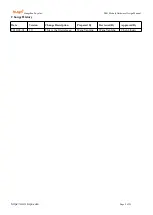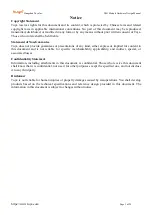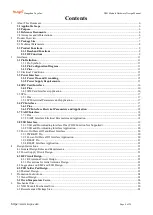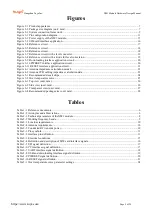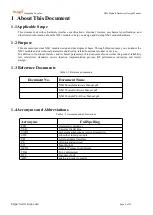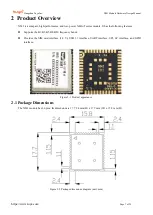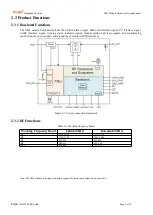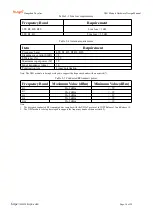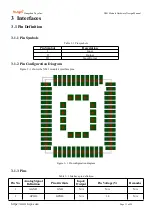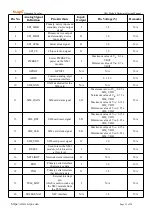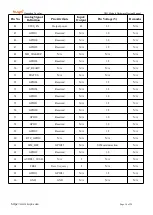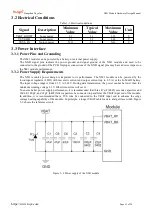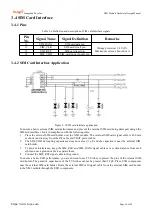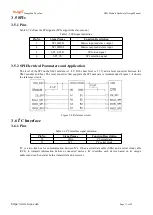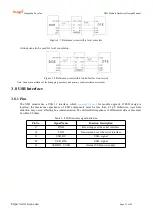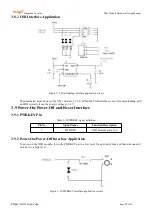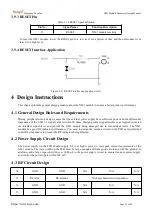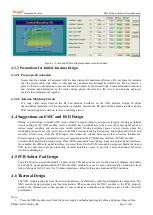
Hangzhou Tuya Inc.
NM1 Module Hardware Design Manual
https://www.tuya.com
Page 8 of 29
2.2 Technical Parameters
Table 2- 1
describes mechanical features, baseband features, RF features, technical standards, and environment
features of the NM1 module.
Table 2- 1 Technical parameters of the NM1 module
Note:
1.
When the NM1 module works at a temperature within the normal operating temperature range
1
, its performance complies with
3GPP standards.
2.
When the NM1 module works at a temperature within the extended operating temperature range
2
, it works properly, has the
SMS* and data transmission functions, and will not have unrecoverable faults. The RF spectrum and network are not affected.
Several indicators, for example, the output power, may exceed the 3GPP limits. After the operating temperature is restored to the
normal operating temperature, all NM1 module indicators can meet 3GPP standard requirements.
3.
A feature with an asterisk (*) is being developed.
Item
Parameter
Specifications
Mechanical
features
Package size and type
17.7 mm x 15.8 mm x 2.6 mm
Stamp hole (52 pins) and base pad (14 pins)
Module
Platform
MT2625
Processor architecture
ARM Cortex-M4
SIM card interface
1.8 V
USB interface
USB 1.1
Voltage
2.1 V to 3.63 V
Working mode
Active: The NM1 module is active and can send and receive data. All functions are
available. An active NM1 module can switch to the idle or PSM mode.
Idle: The NM1 module is in idle state, connected to a network, and can receive paging
messages. An idle NM1 module can switch to the active or PSM mode.
PSM: Only RTC of the module works, and the module is disconnected from the network
and cannot receive paging messages.
The NM1 module is woken up from the PSM mode when the timer expires or the
PWRKEY and PSM_EINT* pins are lowered.
Power-saving
In PSM mode, the NM1 module consumes the minimum power of
5 µA
. The PSM mode
is provided to reduce power consumption and prolong the power supply duration of the
battery.
Serial port
Primary serial interface: transmits AT commands and data. The default baud rate is 115.2
kbit/s. It can also be used for firmware upgrade and the baud rate is 921.6 kbit/s.
Debugging serial interface: exports log information for software commissioning.
Auxiliary serial interface: transmits AT commands and data.
Working current
TBD
RTC
Supported
ADC*
The NM1 module has a 10-bit analog-digit conversion input interface to measure the
voltage.
This interface works in both active and idle modes.
RI signal*
When the NM1 module receives SMS messages or exports URC, it notifies the DTE
over the RI pin.
Network status
indication*
The NETLIGHT signal indicates the module's network connection status.
RF
Frequency band
B1, B3, B5,B8, B20
Maximum TX power
23±2 dBm
Receiving sensitivity
TBD
Main antenna interface
Supported
Antenna interface
Characteristic impedance of 50 ohms. The antenna is provided by a third party, but not
Tuya.
Technical
standard
Data rate
Single-tone: downlink 25.5 kbit/s and uplink 16.7 kbit/s
Multi-tone*: downlink 25.5 kbit/s and uplink 62.5 kbit/s
Network protocol
UDP/TCP/CoAP/LWM2M/PPP*/SSL*/DTLS*/FTP*/HTTP*/MQTT*/HTTPS*
Environment
feature
Temperature
Normal operating temperature: –35°C to +75°C
1
Extended operating temperature: –40°C to +85°C
2
Storage temperature: –40°C to +90°C
Application
SMS*
Text and packet data unit (PDU) modes
Upgrade
Upgrade is performed over the primary serial interface.


